The FPL Data section comprises two expandable/collapsible areas:
- FPL Data
- Proposal Data Entry.
FPL Data
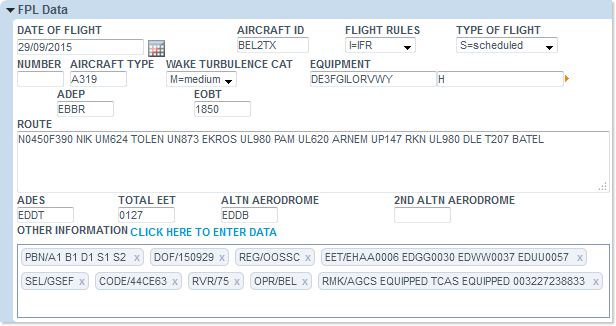 sww
sww
Featuring plain text fields as well as dedicated editing components (wizards), the FPL Data area provides a structured and convenient way to enter or check the flight plan information.
- DATE OF FLIGHT: The date of the flight - you may either type in the date, or use the Date Picker:

Note: you can achieve the same result by editing the value of the DOF indicator in the OTHER INFORMATION field:

- AIRCRAFT ID: Aircraft identification. By default, the field is empty.
- FLIGHT RULES: Flight rules.
In the Flight Assistant mode, a drop-down list allows to select a possible value from:
a) I for IFR.
b) V for VFR.
c) Y for IFR changing to VFR.
d) Z for VFR changing to IFR.
e) Empty – the default value. - TYPE OF FLIGHT: Flight type. A drop-down list allows selecting a possible value from:
a) S for scheduled.
b) N for non-scheduled.
c) G for general.
d) M for military.
e) X for training.
f) Empty – the default value. - NUMBER: Number of aircraft, if more than one in case of formation flights. By default, the field is empty.
- AIRCRAFT TYPE: the type of Aircraft. By default, the field is empty.
- WAKE TURBULENCE CAT: Wake turbulence category indicating maximum certified take-off mass of the aircraft.
A drop-down list allows selecting a possible value from:
a) L for light.
b) M for medium.
c) H for heavy.
d) J for super.
e) Empty – the default value. - EQUIPMENT: Comprises of the following two fields:
a) Radio communication, navigation and approach aid equipment.
By default, both the fields are empty.
b) Surveillance equipment.
A comprehensive wizard facilitates the specification of the equipment and capabilities parameters - see description below. - ADEP: ICAO code of the aerodrome of departure. By default, the field is empty.
- EOBT: Estimated Off-Block time. By default, the field is empty.
- ROUTE: Brings together the values of the following parameters (by default, the field is empty):
- CRUISING SPEED: The true airspeed for the first or the whole cruising portion of the flight.
- LEVEL: Requested cruising level.
- ROUTE: Flight Plan route.
- ADES: ICAO code of the aerodrome of destination. By default, the field is empty.
- TOTAL EET: Total Estimated Elapsed Time (hhmm). By default, the field is empty.
- ALTN AERODROME: ICAO code of the first alternate aerodrome of destination. By default, the field is empty.
- 2ND ALTN AERODROME: ICAO code of the second alternate aerodrome of destination. By default, the field is empty.
- OTHER INFORMATION: List of additional indicators, when relevant (as specified by ICAO for Field 18 of the FPL).
Proposal Data Entry

- Via point(s): List of published points to be over flown. By default, the field is empty.
- Via airspace(s): List of airspaces that must be traversed (in 2D projection). By default, the field is empty.
- Avoiding point(s): List of published points to be avoided. By default, the field is empty.
- Avoiding airspace(s): List of airspaces that must be avoided (in 2D projection). By default, the field is empty.
- Propose only RAD compliant routes: When checked, IFPUV only returns routes that are RAD compliant. If not checked, it returns all possible routes. By default, this field is checked.
- Max number of proposals (1-10): Maximum number of proposed routes required from IFPUV, between 1 and 10. By default, this is field set to 5.
Wizards
EQUIPMENT

Click on the highlighted orange arrow to open the EQUIPMENT wizard - note how the DE3FGILORVWY / H values of the text fields are presented in the editor:
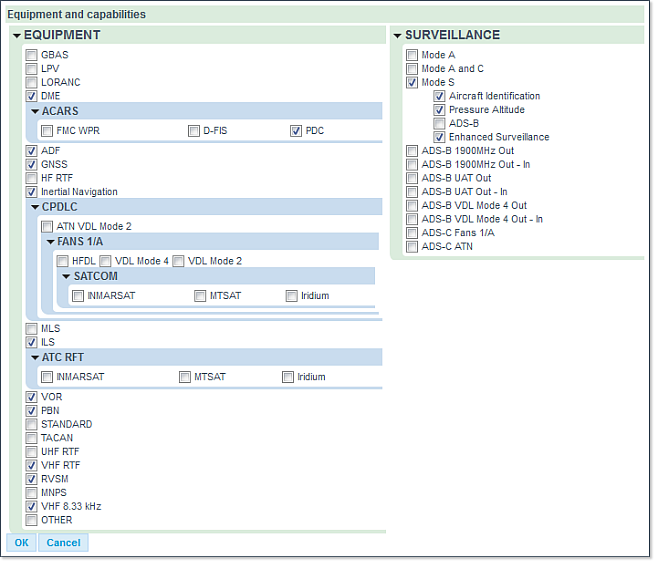
Select the desired parameters and click on the OK button to exit the wizard and apply the new values to the text fields - or click on the Cancel button to discard unwanted changes.
OTHER INFORMATION

Click on the highlighted CLICK HERE TO ENTER DATA link to open the OTHER INFORMATION wizard:
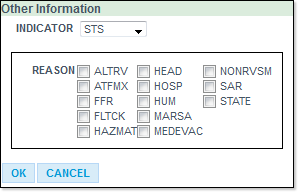
The Other Information wizard is structured as follows:
- INDICATOR: a drop-down menu listing all available indicators (STS, PBN, EUR, NAV, COM, ...)
- Parameter(s): numerical of alphanumerical value, text field(s), tables, etc.
- Action Buttons: the standard OK and CANCEL buttons.
Add Indicator
Example (for the NAV indicator):
1 Select the desired INDICATOR:
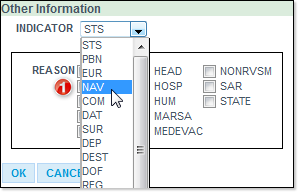
2 Specify the value(s):
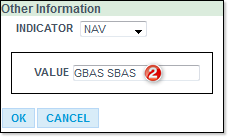
3 Click on the OK button:
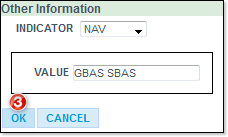
4 The newly created NAV indicator now shows in the OTHER INFORMATION field:

Edit Indicator
Simply click on the desired indicator to open the corresponding wizard.
Delete Indicator
Click on the trailing x link to remove the corresponding indicator from the OTHER INFORMATION field:

More information on how to work with the OTHER INFORMATION wizard can be found in the IFPUV Users Manual (http://www.eurocontrol.int/sites/default/files/content/documents/nm/network-operations/HANDBOOK/ifps-users-manual-current.pdf) - additional support can be obtained from the Contacts and Support tab:
